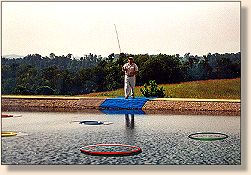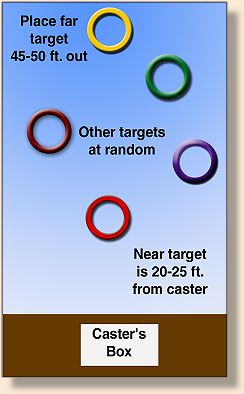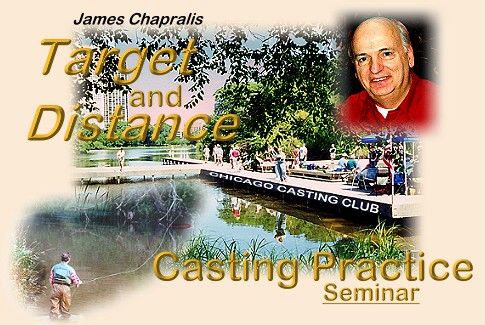|
In order to enjoy better fishing results, it is necessary
for most anglers to practice casting on a continuing basis. Admittedly,
practice is b-o-r-i-n-g, so it's my job to make casting practice so
much fun that you'll almost like it as much as fishing! And down the
road you might even want to enter a casting tournament! And Win!
LESSON THREE: The Dry-Fly Event
 To review: To succeed in fly fishing, we need to become
good casters primarily in terms of accuracy, but also, under
certain circumstances, in distance. In our introduction,
we mentioned that most of us learn the fundamentals of
casting through books or videos, casting schools, or,
perhaps, from a veteran fly-casting friend. But between
fishing trips, these lessons are lost, so it is necessary
to practice our casting periodically. We agreed that usually
practice isn't fun, but we're going to make casting practice
"fun," to a point that many of us will actually look forward to it.
To review: To succeed in fly fishing, we need to become
good casters primarily in terms of accuracy, but also, under
certain circumstances, in distance. In our introduction,
we mentioned that most of us learn the fundamentals of
casting through books or videos, casting schools, or,
perhaps, from a veteran fly-casting friend. But between
fishing trips, these lessons are lost, so it is necessary
to practice our casting periodically. We agreed that usually
practice isn't fun, but we're going to make casting practice
"fun," to a point that many of us will actually look forward to it.
Last week (Lesson Two): We discussed the ground rules (where
to practice), targets and tackle. Today, we're going to practice
a wonderful event, Dry Fly, which is not only a springboard to
successful trout fishing but very helpful in just about every
type of fly fishing where casting accuracy is needed. Let's get
going.
PLACING THE TARGETS: If you did your homework last week you have
acquired some Hula Hoops or made six 30-inch targets from a
brightly colored water hose and duct tape. We'll only need
five targets for this event. You should place the nearest
one at 20 to 25 feet from where you would like to do your
casting (caster's box) and the longest at 45 to 50 feet.
Important: Measure the distance to the far target (most
of us tend to over-estimate distances). Place the other
three targets randomly between the near and far targets,
but not in a straight line. See Diagram.
 THE EVENT: We'll assume that you have your tackle with the
leader and practice fly (see Lesson Two) all set.
THE EVENT: We'll assume that you have your tackle with the
leader and practice fly (see Lesson Two) all set.
Hold the practice fly in the non-casting hand with no more
than the leader plus two feet of line extending beyond rod tip.
Now start false casting so that the line, leader and fly are
moving in the air, back and forth without intentionally striking
the surface in front of you. While false casting, strip fly line
from your reel and let it pass through the rod guides, until you
think you have enough line out to hit the first target. If you
feel that you have let out too much line to hit the target, strip
some in while false casting. After adjustments are made, and your
fly seems to hover above the target on your false cast, make the
final forward cast (presentation) and allow the fly to settle on
the target.
P-E-R-F-E-C-T! Congratulations! Well done.
Okay! So you missed the target. Don't despair; it's a learning
process. You get a demerit for each foot, or fraction of a foot
that the fly lands away from the target. All demerits are
subtracted from a perfect score of 100 for your final score.
Max demerits per ring is 10. More on scores later.
Now you are ready for the second target. Lift the fly off
the ground or water and begin false casting again over the
second target. Adjust your line by stripping out more line
from the reel and letting it feed through the guides. If you
let out too much line, strip some in. When you think the fly
will land in the center of the target, make your forward cast
(presentation) and drop the fly into the target. If you miss,
you will have to add more demerits to your score.
Now proceed to the third target, fourth and fifth target. After
you cast the fifth target, lift the line off the surface and
continue to false cast and at the same time strip in line to
shorten your cast for the closest target. Repeat the procedure
(cast another round of five targets) so that you cast a total
of ten times (twice at each target).
In actual tournaments there are other demerits: the most important
one is that your fly doesn't strike the surface in front of you
("tick") while false casting. If it does, you get three demerits
for each tick.
If you are using a very short or very light fly rod, you might
have trouble reaching the long target (45 to 50 feet). Hitting
the far target is not easy with any fly rod. If such is the case,
bring in the long target five or more feet closer and adjust the
others accordingly.

YOUR SCORE: Why bother to keep score? Because it measures
your progress. Keep track of your scores in a little notebook
and as you continue to practice you will notice improvement
after several weeks.
What's a good score for fly fishers? Let me give you an arbitrary
rating:
Under 50: You need to learn or review fly-casting basics.
Perhaps you haven't been fly casting for a long time? Brush up
on your casting stroke and mechanics and try again.
50 to 65: Hey it's a good start! You'll notice improvement
very quickly as you continue to practice.
66 to 75: You've got the basics down fairly well. Practice,
practice practice.
76 to 85: You're casting very well! Good mechanics. Good
eye-and-hand coordination.
86 to 95: I bet you're the best caster in your fishing
group and catch a lot of trout. I thought so. Continue to practice
so you can move up to the "super elite" class.
96 to 100 (Super Elite Class): You should enter the ACA
National Casting Tournament! You're among the top 1 percent of
fly casters in the world! I need you to help me with my casting.
HOW DOES THIS DRY FLY EVENT HELP OUR FISHING? Obviously
fly-casting accuracy is the most important goal. Wouldn't it be
great if you could come close to your target area when fishing
a stream, pond or lake? While accurate casting is an advantage
for nearly every species that will take a fly, it's very important
in most stream trout fishing. On some brown trout waters, it is
essential! When you practice casting at the targets visualize
a big trout underneath it. It helps to play mind games.
But there are other lessons to be learned from this event. The
ability to strip and adjust line while false casting without
ticking the surface is very important. Most inexperienced
casters lengthen their line by casting on the water: they
make a cast, lift up the line, and make another cast on the
water, and they repeat this until they reach the target.
Forget it! Most wary brown trout are long gone, especially
if you "rip" the line from the surface instead of lifting
it quietly with each "measuring" cast.
You will also learn to judge the distance of the fly as it
swirls back and forth during false casting. This is vital
when you are lengthening your line via false casting in
order to reach a feeding trout.
You will find out the best way of letting out or taking in
line is to run it under your index finger of your casting hand.
It's best to practice on water not only because you can see
where the fly lands better, but because you want the fly to
land softly on the water. In tournament competition, if your
fly sinks on a cast you receive three demerits and you're not
allowed to put a floatant on the fly.
Some experienced tournament fly casters put more power on the
final forward cast but mentally aim it about a couple of feet
above the target. This cushions the cast and allows the fly
lands softly.

Brown trout in clear waters are very difficult to fool and require
delicate, accurate presentations. This is where the Dry Fly Event
comes in handy.
HOW TO MAKE THIS MORE FUN: First you want to keep track
of your scores. By practicing often you will notice improvement
on a continuing basis. Use my arbitrary scoring system above and
move from one level to another. This will fuel your enthusiasm for
more practice. The Dry Fly Event ensures that good fly-casting
basics are used. Simply put, you're not going to score well if:
(1) you have a poor back cast; (2) your rod tip travels in several
planes; (3) your loop is too wide; or, any of the other gremlins
your casting instructor or fly-casting book or video warned you about.
How about getting your fishing buddies involved? Or if you belong
to a Trout Unlimited chapter or any other club where there are a
few fly fishermen, why not hold a casting tournament? If you are
a fly shop owner why not offer periodic casting tournaments with
some nice prizes or awards for your customers or potential customers?
Why not teach your teenage daughter or son the fundamentals of
casting and have some friendly family competition? What a perfect
way to bond in a world that desperately needs family values.
That's it for this week. Now practice! ~ Jim C. Chapralis
Next Week: The Trout Fly Event (where you practice your roll-casting,
wet fly along with the dry fly portion).
About Jim:
Jim Chapralis is a world traveler, a pioneer in the international fishing
travel business, and author, most recently of Fishing Passion, reviewed in
our Book Review section. He is an avid angler - and caster.
Currently involved with the 94th Annual National Casting
Tournament July 29 to August 3, 2002. You can reach Jim via his
website www.AnglingMatters.com
|

 To review: To succeed in fly fishing, we need to become
good casters primarily in terms of accuracy, but also, under
certain circumstances, in distance. In our introduction,
we mentioned that most of us learn the fundamentals of
casting through books or videos, casting schools, or,
perhaps, from a veteran fly-casting friend. But between
fishing trips, these lessons are lost, so it is necessary
to practice our casting periodically. We agreed that usually
practice isn't fun, but we're going to make casting practice
"fun," to a point that many of us will actually look forward to it.
To review: To succeed in fly fishing, we need to become
good casters primarily in terms of accuracy, but also, under
certain circumstances, in distance. In our introduction,
we mentioned that most of us learn the fundamentals of
casting through books or videos, casting schools, or,
perhaps, from a veteran fly-casting friend. But between
fishing trips, these lessons are lost, so it is necessary
to practice our casting periodically. We agreed that usually
practice isn't fun, but we're going to make casting practice
"fun," to a point that many of us will actually look forward to it.


 THE EVENT: We'll assume that you have your tackle with the
leader and practice fly (see Lesson Two) all set.
THE EVENT: We'll assume that you have your tackle with the
leader and practice fly (see Lesson Two) all set.